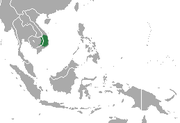| Douc | |
|---|---|

| |
| Red-shanked douc (Pygathrix nemaeus) at the Philadelphia Zoo | |
| Scientific classification | |
| Domain: | Eukaryota |
| Kingdom: | Animalia |
| Phylum: | Chordata |
| Class: | Mammalia |
| Order: | Primates |
| Suborder: | Haplorhini |
| Infraorder: | Simiiformes |
| Family: | Cercopithecidae |
| Subfamily: | Colobinae |
| Tribe: | Presbytini |
| Genus: | Pygathrix É. Geoffroy, 1812 |
| Type species | |
| Simia nemaeus Linnaeus, 1771 | |
| Species | |
|
See text | |
The doucs or douc langurs make up the genus Pygathrix. They are colobine Old World monkeys, native to Southeast Asia, which consists of these 3 species: red-shanked douc, black-shanked douc, and gray-shanked douc.
Description
The doucs are colobine Old World monkeys, which make up the genus Pygathrix. They are native to Southeast Asia.
Classification
Even though they are known as "douc langurs", they are in fact more closely related to the proboscis monkey and snub-nosed monkeys than to any of the langurs. They are part of the subfamily Colobinae of the family Cercopithecidae.
| Common name | Scientific name and subspecies | Range | Size and ecology | IUCN status and estimated population |
|---|---|---|---|---|
| Black-shanked douc | P. nigripes (A. Milne-Edwards, 1871) |
Southeastern Asia
|
Size: 60–76 cm (24–30 in) long, plus 56–76 cm (22–30 in) tail Habitat: Forest Diet: Leaves, as well as seeds, fruit and flowers |
CR
|
| Gray-shanked douc | P. cinerea Nadler, 1997 |
Southeastern Asia
|
Size: About 60 cm (24 in) long, plus 59–68 cm (23–27 in) tail Habitat: Forest Diet: Leaves, as well as buds, fruit, seeds, and flowers |
CR
|
| Red-shanked douc | P. nemaeus (Linnaeus, 1771) |
Southeastern Asia
|
Size: 61–77 cm (24–30 in) long, plus 55–77 cm (22–30 in) tail Habitat: Forest Diet: Leaves, as well as unripe frui, seeds, and flowers |
CR
|
Appearance
Doucs have a distinct appearance. The red-shanked douc characteristically has bright maroon legs and reddish patches around the eyes. In contrast, the grey-shanked douc is less vibrant, with speckled grey legs and orange markings on the face. Both have dappled grey bodies, black hands and feet and white cheeks, although the cheek hairs of the red-shanked douc are much longer. The black-shanked douc has black legs. Their long hind limbs and tail allow these monkeys to be very agile in their treetop habitat.
Behavior
They live in small family groups headed by one adult male. A single group may have several adult females, and many children. Young males unaffiliated with a family group often make their own troops. Females usually bear a single offspring at a time, which is suckled for about a year.
References
- Groves, C. P. (2005). Wilson, D. E.; Reeder, D. M. (eds.). Mammal Species of the World: A Taxonomic and Geographic Reference (3rd ed.). Baltimore: Johns Hopkins University Press. p. 173. ISBN 0-801-88221-4. OCLC 62265494.
- ^ Petter; Desbordes, p. 118
- ^ Duc, H.; Quyet, L. K.; Rawson, B. M.; O'Brien, J.; Covert, H. (2021) . "Pygathrix nigripes". IUCN Red List of Threatened Species. 2021: e.T39828A196138291. doi:10.2305/IUCN.UK.2021-1.RLTS.T39828A196138291.en.
- ^ Long, H. T.; Duc, H.; Quyet, L. K.; Rawson, B. M.; Nadler, T.; Covert, H. (2020). "Pygathrix cinerea". IUCN Red List of Threatened Species. 2020: e.T39827A17941672. doi:10.2305/IUCN.UK.2020-2.RLTS.T39827A17941672.en.
- Berger, Matt (2009). "Pygathrix cinerea". Animal Diversity Web. University of Michigan. Archived from the original on January 24, 2023. Retrieved July 24, 2023.
- ^ Hara, Carla (2003). "Pygathrix nemaeus". Animal Diversity Web. University of Michigan. Archived from the original on August 12, 2023. Retrieved July 24, 2023.
- ^ Coudrat, C. N. Z.; Quyet, L. K.; Duc, H.; Phiaphalath, P.; Rawson, B. M.; Nadler, T.; Ulibarri, L.; Duckworth, J. W. (2020). "Pygathrix nemaeus". IUCN Red List of Threatened Species. 2020: e.T39826A17941247. doi:10.2305/IUCN.UK.2020-2.RLTS.T39826A17941247.en.
- Felix, Dr. Jiri. "Animals of Asia". London: Hamlyn Publishing Group, 1983.
Sources
- Petter, Jean-Jacques; Desbordes, François (2013). Primates of the World: An Illustrated Guide. Princeton University Press. ISBN 978-0-691-15695-8.
External links
- ARKive - images and movies of the black-shanked douc (Pygathrix nigripes)
- Primate Info Net Pygathrix Factsheets
- Fact sheet at San Diego Zoo
| Haplorhini | |||||||||||||||||||||||||||||||||||||||||||||
|---|---|---|---|---|---|---|---|---|---|---|---|---|---|---|---|---|---|---|---|---|---|---|---|---|---|---|---|---|---|---|---|---|---|---|---|---|---|---|---|---|---|---|---|---|---|
| |||||||||||||||||||||||||||||||||||||||||||||
| |||||||||||||||||||||||||||||||||||||||||||||
| |||||||||||||||||||||||||||||||||||||||||||||
| |||||||||||||||||||||||||||||||||||||||||||||
| Taxon identifiers | |
|---|---|
| Pygathrix | |






